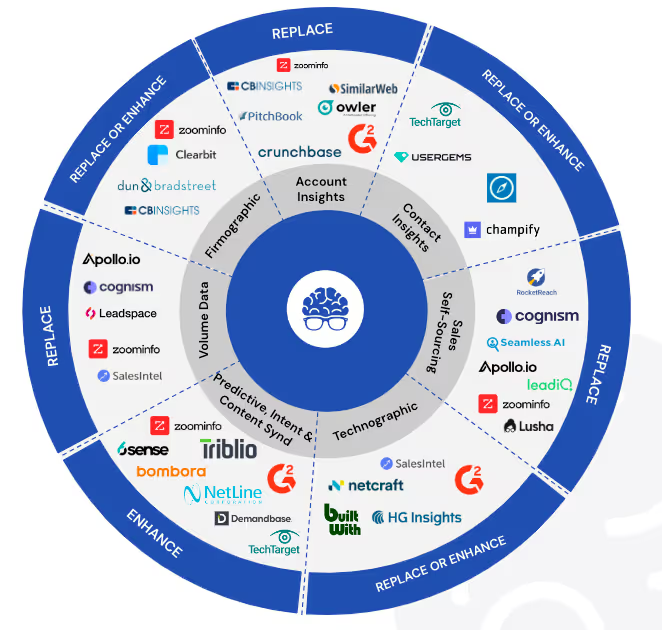In the frenetic day-to-day life of modern Revenue Ops professionals, managing database hygiene can feel like an incessant, Sisyphean task. As we grapple with an avalanche of data pouring into customer relationship management (CRM) and marketing automation systems (MAS), it's easy for data hygiene to slip down the priority list, overshadowed by the urgent demands of process improvements and system integrations. This oversight can lead to eroded trust and operational inefficiencies, as cluttered data systems bog down both strategy and execution.
Companies increasingly rely on platforms like Snowflake to manage and analyze their vast stores of data before pushing it into systems of record or action such as Salesforce, Marketo, Outreach, Salesloft, and Hubspot. However, this approach, while streamlined, often bypasses the crucial task of maintaining clean and relevant data from the outset. The result is a cluttered and less effective operational environment that frustrates efforts to execute precision-targeted marketing and sales campaigns.
A leading expert in data management recently summed up the dilemma: "When organizations try to act on massive volumes of data without first ensuring its quality and relevance, they find themselves drowning in data but starving for insights. It's like trying to find a needle in a haystack, but the haystack keeps getting bigger every second." This metaphor aptly captures the challenge faced by many companies—dealing with the overwhelming quantity of data can obscure the critical insights needed for strategic decision-making.
To combat these issues, top-flight teams focus on proactive data management strategies. This includes establishing rigorous data entry standards, regular audits to identify and eliminate inaccuracies, and employing advanced data cleansing tools to ensure data remains clean and useful long after its initial collection. By prioritizing these practices, Revenue Ops professionals can mitigate the anxiety associated with maintaining a "clean data house" and transform their operations into streamlined, data-driven powerhouses that not only manage but also capitalize on their wealth of information.
Detailed Exploration of Account Qualified Leads (AQLs)
When it comes to establishing a robust data hygiene protocol, the initial focus should squarely fall on Account Qualified Leads (AQLs). This targeted approach allows revenue operations leaders to efficiently manage their resources by honing in on the most promising accounts early in the sales process, rather than becoming bogged down by the daunting task of cleaning and managing a vast array of data across numerous accounts with varying levels of engagement and potential.
Integration of Complex Data Sources
The essence of identifying AQLs lies in the strategic integration of diverse data sources. First-party data, such as direct interactions from webinars or product demos, provides foundational insights into a prospect's interest and engagement level. When combined with third-party intent signals—from browsing behavior on partner sites to engagement with industry-related content—this data forms a robust profile of potential customers who are actively exploring solutions in your sector.
Leveraging Partner and Install Base Data
Partner data can be particularly revealing, offering insights into the prospect's existing solutions and their potential openness to integration or upgrades, which are critical for companies operating in technology and software industries. Similarly, install base data can indicate a prospect’s current technological landscape, revealing opportunities for upselling or cross-selling based on compatibility and current usage patterns.
Refining Focus with Custom Signal Data
Custom signal data acts as a high-resolution lens focusing your AQL efforts. New product launches or major executive movements within a prospect company can signal shifts in strategy or an openness to new solutions, making these accounts ripe for engagement. Strategic initiatives such as sustainability efforts or adoption of new technologies like AI can also indicate a readiness to invest in new solutions that align with these goals.
Adhering to the 90/10 Rule
By applying the 90/10 rule—concentrating 90% of your effort on the top 10% of your accounts, based on these enriched data insights—teams can allocate their resources more effectively. This approach not only optimizes the use of valuable sales and marketing resources but also significantly increases the likelihood of engaging with accounts that have the highest propensity to convert, thereby enhancing overall sales efficiency and effectiveness.
Streamlining Contact Acquisition and Data Hygiene
Streamlining contact acquisition and data hygiene through a focused approach on Account Qualified Leads (AQLs) enables sales and marketing teams to target their efforts more effectively, preventing the dilution of resources across less promising leads. This strategic prioritization ensures that teams concentrate on nurturing and converting high-value prospects, which is vital for efficient sales cycles and maximizing ROI.
Owning the Data Acquisition Pipeline
Owning the data acquisition pipeline is critical to maintaining control over the quality and relevance of the data collected. This control begins with the design of data collection methods that are specifically tailored to capture the most relevant and actionable information about potential leads. By developing a bespoke data acquisition strategy, companies can build datasets that are not only tailored to their specific needs but also dynamically updated in real-time to reflect changes and new insights.
Just-in-Time and Just-for-You Data
The concept of data built "just in time" and "just for you" is fundamental to achieving superior results in sales and marketing. This approach ensures that data is collected, processed, and made available precisely when it is needed, in the most relevant form. For example, if a company identifies a surge in specific market activities or changes in consumer behavior, having real-time, bespoke data allows them to react quickly and effectively, tailoring their marketing strategies to capitalize on these insights.
Benefits of a Tailored Data Approach
- Enhanced Relevance: Data that is specifically gathered and curated based on the unique criteria of an AQL ensures that every piece of information has strategic value, reducing noise and enhancing focus.
- Improved Efficiency: With data that is directly relevant to their needs, teams can quickly identify the most promising leads, reducing the time and resources spent on less likely prospects.
- Higher Conversion Rates: Targeted data increases the likelihood of engaging leads with precisely tailored messages and offers, significantly boosting conversion rates.
- Data Decay Prevention: By owning the acquisition process and continually updating the data as new insights are gathered, companies can prevent data decay, which is often a result of static information losing relevance over time.
- Customization and Flexibility: Owning the data pipeline allows for greater customization and flexibility in data handling and usage, enabling companies to adapt quickly to new challenges or opportunities in the market.
This meticulous approach to handling AQLs not only streamlines the operational process but also sets a strong foundation for sustained business growth and customer relationship management. By starting with a clear, focused strategy on AQLs, companies ensure that their data hygiene practices are both efficient and effective, leading to better data quality, improved sales outcomes, and more successful customer engagements. With bespoke, just-in-time data at their fingertips, companies are well-equipped to make informed decisions that drive significant business impact.
Identifying and Eliminating Ghost Accounts

Refining Account Qualified Leads (AQLs) by removing Ghost Accounts is pivotal to maintaining the integrity and effectiveness of your data management strategy. Here's a more detailed look at the three primary forms of Ghost Accounts and the specific challenges they present:
1. Duplicates
Example: Companies like LeadGenius and MobileWorks might be registered under different names in your CRM but actually refer to the same business entity. This common issue arises from acquisitions, rebrandings, or simply entries by different team members who are unaware of the duplication.
Impact: Duplicate accounts can severely disrupt sales processes. They often lead to internal conflicts over account ownership, confused communication efforts, and wasted resources as different team members may unknowingly pursue the same prospect. Moreover, analytics and reporting can be skewed, leading to misinformed decision-making based on inflated data.
2. Good-fit Accounts with Poor Data
Example: Many small to medium-sized businesses (SMBs) may not use corporate email addresses, making it difficult to reach the decision-makers. Instead, these businesses might use generic email services, which can dilute the effectiveness of targeted marketing campaigns and increase the risk of communications landing in spam folders.
Impact: The lack of reliable contact information hampers effective engagement and follow-up strategies, leading to lower conversion rates and potential revenue losses. For revenue operations, it's crucial to enhance data collection methods or use advanced data verification tools to ensure that even SMBs in the database have accurate and usable contact details.
3. Misclassified Accounts
Example: An account might be initially tagged as a high-value prospect in the healthcare sector, such as a medical spa. However, upon further investigation, it might turn out to be a business unrelated to healthcare, like a pool service, due to a misinterpretation of the business's services or an error in data entry.
Impact: Misclassification can lead to misallocated resources, as sales and marketing teams may target companies with messages and offers that are irrelevant to their actual business. This not only wastes efforts but also damages the company's credibility and can annoy potential customers. Misclassification also complicates territory assignments and quota management, leading to inefficiencies and frustration within sales teams.
Regular Auditing and Cleansing
To tackle these issues, it is crucial to implement regular auditing and cleansing of your AQL pool. This process involves systematic checks for data accuracy and completeness, the use of sophisticated deduplication tools to identify and merge duplicates, and rigorous validation procedures to ensure all data reflects current and accurate information about each account. By maintaining a clean and reliable AQL pool, companies can optimize their targeting strategies, improve the efficiency of their sales and marketing efforts, and ultimately drive better business outcomes.
Quarterly Reviews and Data-Driven Adjustments
Undergoing this process quarterly allows teams to reassess and realign good accounts, team assignments, and target account alignment. This continuous refinement leads to improved win rates, sales velocity, and average deal size. Tailoring data analysis to specific industries enhances precision in targeting and strategy formulation.
The Perils of Relying on Large Prebuilt Databases
Turning to large, prebuilt databases for contact discovery and insight generation often results in inaccurate and outdated information. Instead, partnering with a data provider that offers bespoke, regularly updated data ensures maximum relevance and contractibility. This tailored approach not only streamlines contact acquisition but also significantly enhances the quality of interactions with potential customers.
Leveraging Quarterly Insights for Continuous Improvement
Conducting a close-won analysis at the end of each quarter allows teams to identify emerging trends, necessitating further segmentation and custom data collection to seize new market opportunities. This ongoing cycle of evaluation, adjustment, and refinement is crucial for sustaining and enhancing data hygiene practices among top-tier revenue teams.
Must Follow Resources
For Revenue Operations professionals aiming to excel in their field, utilizing the best resources is essential. Here are five top resources that offer valuable insights, industry trends, and operational strategies:
- Pavilion (formerly Revenue Collective) - This private membership community is designed for sales, marketing, and operations leaders. Pavilion offers a robust platform for networking, shared learning, and access to exclusive events, webinars, and content that focus on the challenges and strategies relevant to revenue operations.
- Modern Sales Pros (MSP) - MSP is a vital resource for anyone involved in Revenue Operations. It's one of the largest communities specifically for sales and revenue operations professionals. The platform offers an invaluable mix of peer learning, real-time discussions, and access to a vast library of resources that tackle the nuances of modern sales environments.
- GTMnow (formerly Sales Hacker) - Known as a highly regarded community and resource hub, Sales Hacker offers a plethora of articles, webinars, and forums on topics related to sales operations and revenue growth. It is particularly useful for discovering innovative sales strategies and learning from industry experts.
- OpsStars - A conference series and community that specifically focuses on operations roles within sales, marketing, and customer success. OpsStars is an excellent resource for staying updated on the latest tools, trends, and strategies in the field of revenue operations.
- Forrester’s SiriusDecisions Research - This global B2B research and advisory firm provides rich insights and operational frameworks tailored to revenue operations. Accessing their research can help professionals benchmark their operations against industry standards and gain strategic guidance.
- Wizards of Ops - A growing community and resource platform for operations professionals. It features interviews, podcasts, and articles that provide real-world insights and actionable advice tailored to the unique challenges faced by operations teams in various industries.
These resources collectively offer a mix of thought leadership, practical tools, and community support, helping Revenue Ops professionals effectively navigate their complex roles and drive growth within their organizations.
Putting a bow on it
For companies aiming to excel in today’s competitive market, stepping away from generic, oversized data pools and embracing a meticulous, data-centric approach is not just beneficial—it's imperative. By focusing on high-quality, relevant data and rigorously maintaining data hygiene, revenue leaders can ensure their teams are primed for success, equipped with the insights needed to engage effectively with the best-fit accounts. This bespoke methodology, championed by companies like LeadGenius, is indeed the future of effective data management in customer and revenue operations.




